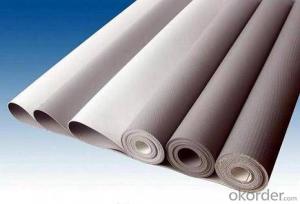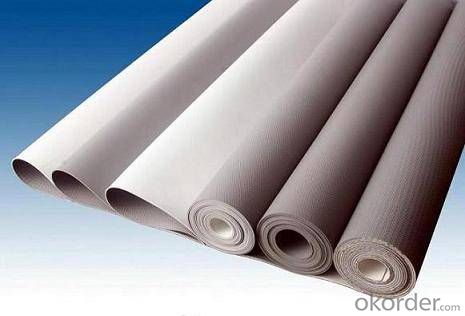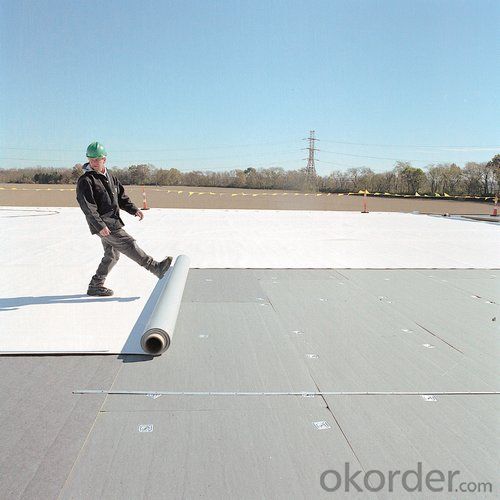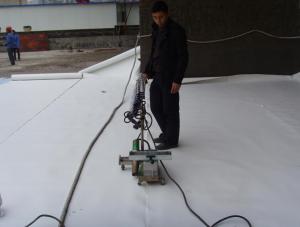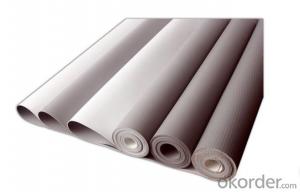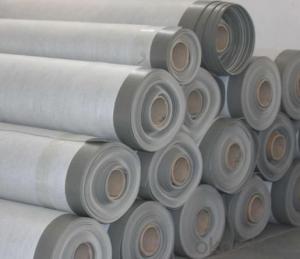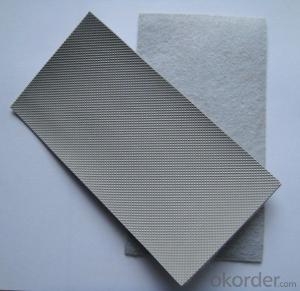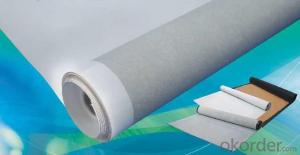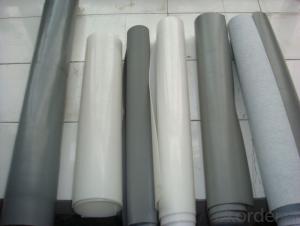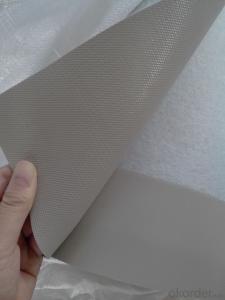PVC Waterproof Membrane Nonwoven Polyester Reinforced
- Loading Port:
- China main port
- Payment Terms:
- TT OR LC
- Min Order Qty:
- 5000 m²
- Supply Capability:
- 100000 m²/month
OKorder Service Pledge
OKorder Financial Service
You Might Also Like
1. Brief Introdustion of PVC Waterproofing Membrane:
The P series waterproofing membrane is a heat-weldable membrane produced with an integral polyester reinforcement for high strength,for use in a Magical Stone's solution system. Its excellent performance of resistance to plasticizer extraction and migration, extend the product's life and more friendly to environment.
2. Features of PVC Waterproofing Membrane
1) Excellent aging resistance. Service life of roofing material is over 20 years;
service life of underground material is over 50 years.
2) Root resistant penetration, specially used on planting roof.
3) Welding installation. Joints are solid and environment friendly, no pollution.
4) High tensile strength, good elongation and dimensional stability.
5) Good plasticity, easy and suitable for details installation.
6) Fireproof. Fire extinguished out of the ignition resource.
7) Surface is smooth, no fading and dirty resistant.
3. Specification of PVC Waterproofing Membrane
Length | 20m/roll or customized |
Width | 2.05m |
Thickness | 1.2mm; 1.5mm; 2.0mm |
Type | Homogeneous, Reinforced, Fabric back |
If Exposed | Exposed and Non-exposed |
Color | White, Grey or customized |
4. Types of PVC Waterproofing Membrane
N1—Exposed PVC waterproof membrane.
(It is mainly used as details treatment for exposed roof waterproof project)
N2—Non-exposed PVC waterproof membrane.
(It is mainly used as details treatment for non-exposed roof waterproof project)
L1—Exposed PVC waterproof membrane with fabric.
(It is mainly used for exposed roof waterproof project)
L2—Non-exposed PVC waterproof membrane with fabric.
(It is mainly used for non-exposed roof waterproof project)
W1—Exposed reinforced PVC waterproof membrane .
(It is mainly used for steel structure roof exposed waterproof project)
W2—Exposed reinforced PVC waterproof membrane .
(It is mainly used for steel structure roof non-exposed waterproof project)
5. FAQ of PVC Waterproofing Membrane
a.Can we get some samples before place order?
Answer: We can send the free samples to you by freight collect.
b.How many years can your PVC membrane guarantee?
Answer: We will guarantee the quality for 5 years at least.
c.Which countries you ever export the product?
Answer: We export the PVC membrane to South Africa, Middle east and even European countries.

- Q: Can a waterproofing membrane be used in rooftop gardens or green roofs?
- Yes, a waterproofing membrane can be used in rooftop gardens or green roofs. It is an essential component to prevent water leakage and protect the underlying structure from moisture damage. The membrane acts as a barrier, preventing water from penetrating the roof and causing potential structural issues. This ensures that the rooftop garden or green roof remains well-maintained and functional.
- Q: Does a waterproofing membrane require any special considerations for installation in seismic zones?
- Special considerations must be taken into account when installing a waterproofing membrane in seismic zones due to the risk of earthquakes and ground movements. To withstand the potential movements and vibrations caused by seismic activities, it is crucial to ensure that the membrane is capable of withstanding stress and strain. When installing a waterproofing membrane in seismic zones, several factors should be considered: 1. Flexibility: The membrane should possess sufficient flexibility to accommodate the movement of the building structure during an earthquake. It should be able to stretch, contract, and withstand dynamic forces without tearing or compromising its waterproofing properties. 2. Compatibility: It is important to select a waterproofing membrane that is compatible with the building materials and systems used in seismic zones. This ensures that the membrane bonds well with the substrate and other construction components, creating a seamless and robust waterproofing system. 3. Reinforcement: In areas with high seismic activity, it is recommended to reinforce the waterproofing membrane with additional layers or reinforcements. This can be achieved by incorporating a fabric or mesh layer to enhance the membrane's tensile strength and resistance to tearing caused by seismic movements. 4. Proper installation techniques: The installation of the waterproofing membrane in seismic zones should adhere to specific guidelines and techniques to ensure its effectiveness. This may involve using specific adhesives, primers, or mechanical fastening systems to securely install the membrane. 5. Quality control: Regular inspections and quality control measures should be implemented during and after the installation process. This allows for the identification of any potential issues or deficiencies in the waterproofing system, enabling prompt repairs or adjustments to be made. By addressing these special considerations, the installation of a waterproofing membrane in seismic zones can effectively safeguard the building structure against water intrusion and potential damage caused by earthquakes. Consultation with experienced professionals and adherence to industry standards and guidelines are imperative for a successful installation in these challenging environments.
- Q: DTM.E polyester composite waterproofing membrane, cheaper than the asphalt membrane?
- the product in line with GB18173-2006 "polymer waterproof material" national standards.
- Q: Can a waterproofing membrane be used for a rooftop garden protection?
- Yes, a waterproofing membrane can be used for rooftop garden protection. A waterproofing membrane is designed to prevent water from seeping through the roof, which makes it an ideal choice for protecting a rooftop garden. It creates a barrier that keeps water out, preventing any potential damage to the structure of the rooftop or the plants in the garden. In addition to providing waterproofing, some membranes also offer other benefits such as UV resistance and root resistance, which further enhance their suitability for rooftop garden protection.
- Q: Can a waterproofing membrane be used for disaster relief structures?
- Indeed, disaster relief structures can benefit from the utilization of a waterproofing membrane. These membranes are specifically engineered to impede water infiltration and thus serve as an effective means of safeguarding temporary constructions in areas affected by calamities. Whether it be a transitory dwelling, medical establishment, or storage facility, a waterproofing membrane offers a formidable defense against precipitation, floods, and other water-related predicaments. By guaranteeing the dryness of the structure, it not only upholds the integrity of the relief edifice but also shields its inhabitants or stored provisions from water-induced harm. Moreover, waterproofing membranes are frequently lightweight, facile to install, and can be rapidly deployed during emergency scenarios, rendering them highly suitable for endeavors related to disaster relief.
- Q: Can a waterproofing membrane be used for zoos or aquariums?
- Zoos or aquariums can definitely utilize waterproofing membranes. These membranes are specifically designed to create a protective barrier against water infiltration, making them an excellent choice for preventing water damage and leakage in such environments. They can be applied to different surfaces, such as concrete or steel, to establish a watertight seal and prevent water from seeping into the structure or habitat. Aquariums often rely on waterproofing membranes to ensure that their tanks remain completely watertight and free from leaks, as this is crucial for the well-being of the aquatic animals. Similarly, in zoos, waterproofing membranes can be applied to animal enclosures or exhibit areas to safeguard the structures from water damage and uphold a safe and healthy environment for the animals. Moreover, these membranes possess resistance against various chemicals and can withstand harsh conditions, making them an excellent safeguard against potential chemical spills. All in all, waterproofing membranes are a highly suitable option for zoos or aquariums, as they offer an effective solution for preserving the integrity of the structures and habitats, averting water damage, and ensuring the safety and well-being of the animals.
- Q: Are waterproofing membranes suitable for exterior use?
- Yes, waterproofing membranes are suitable for exterior use. They are designed to provide a protective barrier against water infiltration and can be applied to various exterior surfaces such as roofs, foundations, and walls. Waterproofing membranes are effective in preventing water damage and maintaining the integrity and longevity of the structure.
- Q: Can a waterproofing membrane be used on drywall surfaces?
- Indeed, it is possible to utilize a waterproofing membrane on surfaces composed of drywall. Drywall, being a material with porosity, is prone to damage caused by moisture, particularly in areas that are inclined to high levels of humidity or exposure to water, such as bathrooms or basements. The application of a waterproofing membrane on drywall aids in the creation of a protective barrier against moisture, thereby preventing the infiltration of water and potential harm. This membrane can be implemented either as a liquid coating or as a sheet membrane directly applied onto the drywall surface. It is of utmost importance to adhere to the instructions provided by the manufacturer and guarantee a proper installation, as this will result in effective waterproofing and safeguard the drywall from issues associated with moisture, such as the growth of mold, mildew, and rot.
- Q: Can a waterproofing membrane be used on TPO roofs?
- TPO roofs, known for their durability and energy efficiency, can still experience leaks and water damage over time. To address this, a waterproofing membrane can be applied to enhance the waterproofing capabilities of a TPO roof. A waterproofing membrane is a thin layer of material that prevents water infiltration. It is typically made from synthetic materials like modified bitumen, EPDM, or PVC. These membranes effectively create a barrier against water, protecting the underlying roof structure from leaks and potential damage. When applying a waterproofing membrane on a TPO roof, it is crucial to ensure compatibility between the materials. The membrane must be specifically designed for TPO roofs and approved by the TPO roofing system manufacturer. This ensures compatibility and avoids adverse reactions or voided warranties. Installing a waterproofing membrane on a TPO roof involves surface cleaning and preparation, applying primer if needed, and adhering the membrane using an appropriate adhesive or heat welding method. Once installed, the membrane acts as an additional protective layer, preventing water from penetrating the TPO roof system and causing damage. In conclusion, a waterproofing membrane can be utilized on TPO roofs to enhance waterproofing and safeguard against leaks. However, it is vital to select a membrane designed for TPO roofs and approved by the manufacturer. Proper installation and regular maintenance are essential to maximize the longevity and effectiveness of the waterproofing membrane on a TPO roof.
- Q: Can a waterproofing membrane be used for a retaining wall drainage?
- Yes, a waterproofing membrane can be used for retaining wall drainage. The membrane helps to prevent water from seeping into the retaining wall and causing damage. Additionally, it can also help to channel water away from the wall, promoting proper drainage.
Send your message to us
PVC Waterproof Membrane Nonwoven Polyester Reinforced
- Loading Port:
- China main port
- Payment Terms:
- TT OR LC
- Min Order Qty:
- 5000 m²
- Supply Capability:
- 100000 m²/month
OKorder Service Pledge
OKorder Financial Service
Similar products
Hot products
Hot Searches
Related keywords
